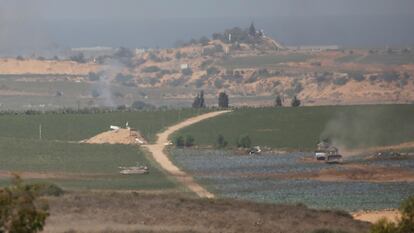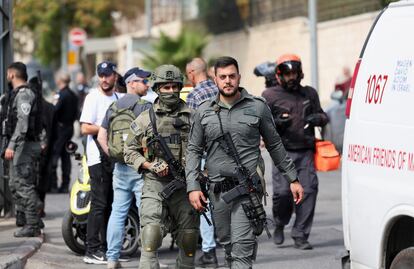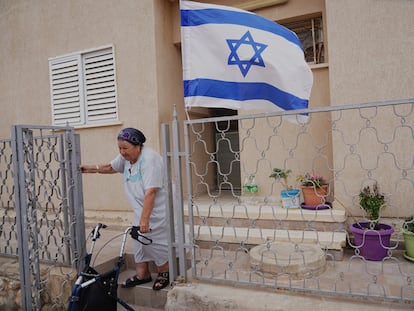Israeli tanks approach Gaza City as the UN warns of airstrikes near hospitals
A police officer was seriously injured in Jerusalem after being stabbed by a man who was later shot dead

Israel is expanding its ground invasion of the Gaza Strip by increasing the presence of soldiers, tanks and other vehicles without slowing down the pace of the airstrikes. The first tanks approached Gaza City, the capital, on Monday through one of the northern suburbs, while troops have cut off the main road in the enclave, according to the Efe and France Presse agencies.
The humanitarian situation in Gaza is being described as catastrophic. The United Nations has warned that bombings are taking place near hospitals where, in addition to many wounded people, many families are sheltering from Israeli strikes. In East Jerusalem, a police officer was stabbed at a gas station and remains in serious condition; the assailant has been shot dead, as confirmed by one of EL PAÍS’ special correspondents.
The attack on the police officer occurred near what is known as the Green Line that separates the Palestinian section in the east from the western part and near the United States consulate. Immediately afterward, incidents broke out between ultra-Orthodox Jews, whose neighborhood is a few feet away, and Palestinians who were in the area. The attack, which comes amid growing tension and violence over the war, is reminiscent of the Stabbing Intifada, which took place seven years ago.
Israeli troops have been inside the Gaza Strip as of Friday night. In recent hours there have been clashes in which “dozens of terrorists” who had taken refuge in buildings and tunnels have died, according to the daily report released by Israeli authorities. Airstrikes are taking place near important hospitals. The U.N. mentioned three: Al Shifa and Al Quds, both in Gaza City, and the Indonesian Hospital in the north. “The 10 hospitals that remain operative in Gaza City and in the north have received reiterated evacuation orders in the last few days,” said the U.N., noting that these facilities are sheltering around 117,000 internally displaced people, in addition to thousands of patients.
At the same time, two other fronts remain open as a result of the Israeli response to the Hamas attack on October 7. In the West Bank, an Israeli raid left four Palestinians dead in Jenin. On the border with Lebanon, the Shiite group Hezbollah claims to have shot down an Israeli drone.
The military ground operation is being carried out with close cooperation between the troops deployed inside Gaza and the aerial forces. This is how, with collaboration from the ground, Israeli planes managed to shoot down a building housing more than 20 members of the Islamic fundamentalist militia, according to the Israeli report issued on Monday morning. EL PAÍS, like the rest of the international media, cannot access Gaza due to the Israeli blockade to independently verify this information.

Also on Monday, Hamas released a video that shows three female hostages out of the more than 200 people who were kidnapped during the October 7 attack in Israel. In the video, one of the women criticizes Israeli Prime Minister Benjamin Netanyahu’s management of the crisis and demands the release of Hamas prisoners in exchange for their own. Netanyahu called the footage “cruel psychological propaganda.”
Netanyahu himself has identified the three women in the video as Yelena Trupanov, Daniel Aloni and Rimon Kirsht. “You promised to free us all. Instead, we bear your political and military failure,” Aloni is seen saying on camera, addressing the Israeli prime minister. “Release their prisoners. Set us all free. Let us return to our families! Now! Now!” she exclaims, alluding to the prisoner exchange that Hamas said it wants. EL PAÍS could not verify the conditions in which the approximately one-minute video was recorded. “Our hearts go out to you and the other abductees,” said the prime minister in a statement. “We are doing everything to bring all the kidnapped and missing people home.”
A key urban battle
In the large city that housed more than a million people until the beginning of the ongoing war, a key battle is expected to be fought that could last several weeks, according to several experts. The network of tunnels controlled by Hamas, which governs the Strip, and the more than 200 hostages in its possession will be determining aspects in a battle that is putting Netanyahu’s role in question.
Hamas is trying to negotiate a five-day ceasefire to be able to deal with the humanitarian crisis of the 2.3 million inhabitants of the Strip in exchange for releasing the kidnapped civilians, according to official sources from Qatar, which has been negotiating for weeks between the parties, Reuters reported.

Since the ground invasion began on Friday night, more than 600 targets have been hit, including weapons depots, anti-tank missile launching positions, militant hideouts and other locations used by Hamas, the Israeli statement added.
Israel is insisting that the population of northern Gaza evacuate to the south, supposedly so it can fight Hamas without civilian casualties. But airstrikes are taking place across the Strip, from north to south, and the 8,300 dead reported by Gaza health authorities, most of them civilians, are distributed all over the territory. There are still hundreds of thousands of people living in Gaza City, amid growing warnings that the ground invasion could multiply the number of fatalities.
Sign up for our weekly newsletter to get more English-language news coverage from EL PAÍS USA Edition
Tu suscripción se está usando en otro dispositivo
¿Quieres añadir otro usuario a tu suscripción?
Si continúas leyendo en este dispositivo, no se podrá leer en el otro.
FlechaTu suscripción se está usando en otro dispositivo y solo puedes acceder a EL PAÍS desde un dispositivo a la vez.
Si quieres compartir tu cuenta, cambia tu suscripción a la modalidad Premium, así podrás añadir otro usuario. Cada uno accederá con su propia cuenta de email, lo que os permitirá personalizar vuestra experiencia en EL PAÍS.
¿Tienes una suscripción de empresa? Accede aquí para contratar más cuentas.
En el caso de no saber quién está usando tu cuenta, te recomendamos cambiar tu contraseña aquí.
Si decides continuar compartiendo tu cuenta, este mensaje se mostrará en tu dispositivo y en el de la otra persona que está usando tu cuenta de forma indefinida, afectando a tu experiencia de lectura. Puedes consultar aquí los términos y condiciones de la suscripción digital.
More information
Archived In
Últimas noticias
Welcome to the post-religion era: The idea of Christianity as the absolute truth has become obsolete
‘I thought you would like it’: The risky sexual practice popularized by TV shows and TikTok
The digitalization of tourism: ‘They promise experiences and gave us the worst possible one’
Mexican peso defies uncertainty with forecasts of a new period of stability in 2026
Most viewed
- Sinaloa Cartel war is taking its toll on Los Chapitos
- Oona Chaplin: ‘I told James Cameron that I was living in a treehouse and starting a permaculture project with a friend’
- Reinhard Genzel, Nobel laureate in physics: ‘One-minute videos will never give you the truth’
- Why the price of coffee has skyrocketed: from Brazilian plantations to specialty coffee houses
- Silver prices are going crazy: This is what’s fueling the rally










































